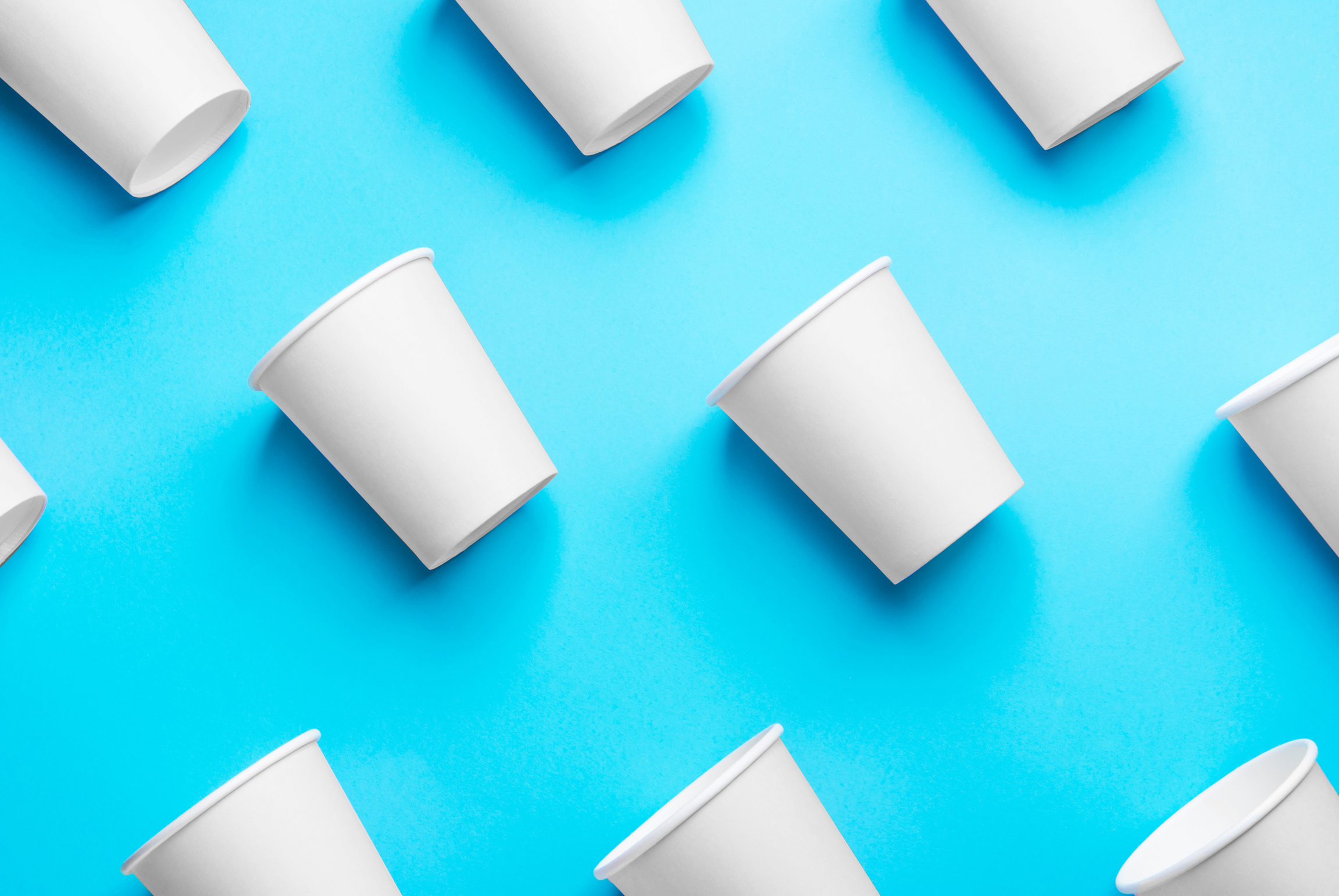PACKAGING INNOVATION
The first step to reimagining foodservice packaging to be more sustainable and circular begins with rethinking materials.
Together with our Consortium partners, we advance new material innovation that enables more circular packaging––keeping resources out of landfills and our oceans. With 250 billion cups mostly ending up as waste, our first step was clear: the to-go fiber cup.
First Up, The Cup
NextGen Cup is the Consortium’s first initiative under Packaging Innovations––focused on the fiber, hot and cold, to-go cup system.
The Difficulty with Today’s Cups
Show moreThere are two core issues with fiber cups: how they’re made and how the materials they’re made of are valued. Most fiber cups have a plastic liner to prevent leaks. The fiber and plastic are recyclable once separated, but limitations and inconsistencies in recycling infrastructure around the world mean that in most markets, these materials aren’t easily recovered. And while recycled fiber and plastic are valuable, what’s currently recoverable from cups doesn’t sell for much, so there’s no strong incentive for recyclers to recover the materials.
The food and beverage service industry has been working toward a more sustainable cup for many years, but we have yet to find a solution that addresses the structural and commercial systems that produce, collect and recover our cups, while also meeting industry standards.
That’s where the NextGen Consortium comes in. Through our first initiative, NextGen Cup, we aim to identify and commercialize cup solutions that minimize environmental impact, are valuable to recovery systems and meet health, safety and performance standards.
What is NextGen Cup?
Show moreNextGen Cup is the first initiative by the NextGen Consortium, a multi-year partnership of food and beverage industry leaders to address single-use foodservice packaging waste globally. Through NextGen Cup, we aim to advance recoverable solutions for the fiber, hot and cold, to-go cup system.
Through our NextGen Cup Challenge, a global design competition, and our NextGen Circular Business Accelerator we identified innovative, alternative cup solutions to bring to scale, while working to align these new solutions with the broader cup recovery infrastructure. It’s critical that we know exactly what happens to cups at end-of-use, so that we can better understand how to keep their valuable materials in circulation and out of landfills.
NextGen Cup has a three-stage, multi-year approach. First, we identified innovative high-potential cup solutions that could work globally. We then tested solutions and provided critical resources and industry expertise to accelerate their commercialization. Finally, NextGen will match solutions to value chain partners to provide piloting opportunities to scale the solution.
Why NextGen Cup?
Show moreEvery day, millions of people around the world drink from fiber cups. They’re safe, functional and convenient––so much so that globally, more than 250 billion cups are produced each year.
But convenience comes with environmental consequences. Trees are cut down for the fiber and petroleum is extracted for making plastic, in the process, degrading ecosystems and emitting greenhouse gases that cause climate change. While many cups are potentially recyclable, in practice the vast majority end up in landfill, wasting valuable resources.
Cup Challenge
In 2018, we launched the NextGen Cup Challenge, an open, global design competition seeking to identify and commercialize existing and future solutions for the single-use, hot and cold, fiber cup system.

Business Accelerator
The NextGen Circular Business Accelerator brought to market new and innovative cup solutions, including reusable cup systems. We took selected winning ideas from the Cup Challenge to the next level.

Piloting in Action
We continue to bring NextGen cups to market through in-market trials and pilots with brand partners and at cafes across the country. Read more about our most recent pilots in the San Francisco Bay Area below.
Read More Insights from the Pilots
FAQ
Why are recycling and composting fiber cups the focus? Shouldn’t we be encouraging reusable cups?
The NextGen Cup Challenge welcomed reuse and alternative delivery system submissions, and three of the 12 NextGen winners were reusable cup systems.
Show moreNextGen Consortium founding members, Starbucks and McDonald’s, recognize the need to reduce single-use packaging in their operations and implement strategies to do so––learn more about Responsibility at Starbucks and Scale for Good at McDonald’s. Customers today want the convenience of fiber cups, and the cups remain a cost-effective way to serve hot and cold beverages.
We believe advancing the material value and recoverability of fiber cups while meeting the market’s current needs is a critical step to developing other sustainable single-use packaging. In the process, we aim to identify and commercialize solutions that meet regional needs and overcome recovery infrastructure challenges––all necessary steps to build a global circular economy.
Aren’t single-use fiber cups currently recyclable or compostable?
Standard fiber cups have a plastic lining to prevent liquids from leaking and the cup becoming soggy.
Show moreAlthough they may be recycled or composted in some markets, in the vast majority of regions, the infrastructure doesn’t exist to recover these materials. And while recycled fiber and plastic are valuable, what’s currently recoverable from cups doesn’t sell for much, so there’s no strong incentive for recyclers to recover the materials.
Organizations like the Foodservice Packaging Institute collaborate with recyclers, end markets and composters to recover more fiber cups and other foodservice packaging. We believe recovery of these materials will grow if we design cups to be recoverable and increase the value of the recovered material.
Why haven’t we found a solution to the single-use cup yet?
The foodservice industry has been working toward a more sustainable cup for many years, but we have yet to find a solution that addresses the structural and commercial systems that produce, collect and recover our cups.
Show moreThe industry’s stringent health, safety and performance standards––designed to keep us all safe––also make it challenging for a new commercially viable solution to be brought to life at a global scale. Since different markets have varying recycling capabilities, we may need more than one solution to fit all countries’ circumstances. NextGen Cup brings together the relevant players to enable new cup solutions that accommodate different regional systems and produce materials worth recovering.
What do terms like ‘recovery’ and ‘recoverable’, ‘global scale’, ‘fiber’ and ‘single-use’ mean?
There are certain nuances to keep in mind.
Show moreRecoverable
After a customer discards a fiber cup, the collection, processing and use of the cup’s raw material components is referred to as recovery. For the hot and cold fiber cup to be recoverable and kept out of landfills, its raw material components must have value to end markets that can use the materials and to the various businesses that would meet the needs of those markets. Recovery markets can include, but aren’t limited to, recycling and composting.Global Scale
Globally, 250 billion hot and cold fiber cups are distributed each year––in cafes and restaurants, event venues, movie theaters, schools, hospitals and more. The public and private recovery infrastructures that serve these businesses, including waste carters and materials recovery facilities, varies widely across countries and regions. NextGen Cup seeks to identify recoverable solutions that accommodate various infrastructures, or are specific to one, and then commercialize new solutions so they work for the entire 250 billion fiber cup market and not just one company or application.Fiber
Wood fibers are typically cellulosic elements extracted from trees and used to make materials including paper. The hot and cold fiber cup, also called the paper cup, is typically a single-use, disposable cup comprised of fiber and wax or plastic linings to prevent leaks.Single-Use
Designed to be used once, single-use packaging is used across markets and industries and is safe, functional and convenient. But with convenience comes negative environmental consequences including greenhouse gas emissions, ecosystem degradation and wasted resources. Single-use cups are a prevalent global waste issue. NextGen Cup’s search for recoverable fiber cup solutions can lead to opportunities applicable across the single-use packaging landscape.

